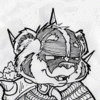
Inspired after being wrangled into a poster project, I decided to add Mitch Marmel's Character to a more interesting setting in a somewhat realistic situation. Here, Tali is working the Swing Shift at Lockheed riveting the skins on fighter wings in the late 1940s. It's also a little homage to the young ladies who during WWII took their place in the factories while their young men went off to war.
Category Artwork (Traditional) / Fantasy
Species Housecat
Size 757 x 1000px
File Size 270.6 kB
Clecos are used to temporarily hold two pieces of metal together before riveting (examples of what they look like -> http://www.averytools.com/products.asp?dept=9 ). They allow assemblers to put parts together, verify tolerances and whatnot, before being attached together permanently with rivets.
Thanks for the kind words. I recall your mentioning your Great Aunt's efforts during the war from awhile ago. There's a monument to the "Rosie the Riveters" who worked in the shipyards in Richmond, not too far from here. That is one of the sights I really want to visit.
...There you go. When I was in the IPMS chapter at La Habra, we had a gal who flew for the "WASPs" speak at one of our club meetings. I was really impressed by her good humor and "Pluckiness." In fact, she claimed she could fly anything, even a bathtub, as long as it had wings. She also pointed out that there was great discrimination and sabotage carried out by male mechanics and flight crews of that time. One of their most notorious tricks was to put a wooden cone in the fuel tanks which would result in the aircraft running dry prematurely, and crashing. Such an incident killed one of the speaker's lady friend pilots.
Hear hear! Ever since posting this image I've been introduced to friends and their older relations who either had mothers or grandmothers that worked in the factories during WW II. Some told tales of heartbreak and tragedy such as those where some women had to endure injuries that would these days send a worker home for a week, finish their shift, and be back on the lines the next day. Of course back then, any amount of "Slacking" was considered a hinderence to the War Effort, and any production lost by an individual was considered beneficial towards the Enemy.

 FA+
FA+
















Comments